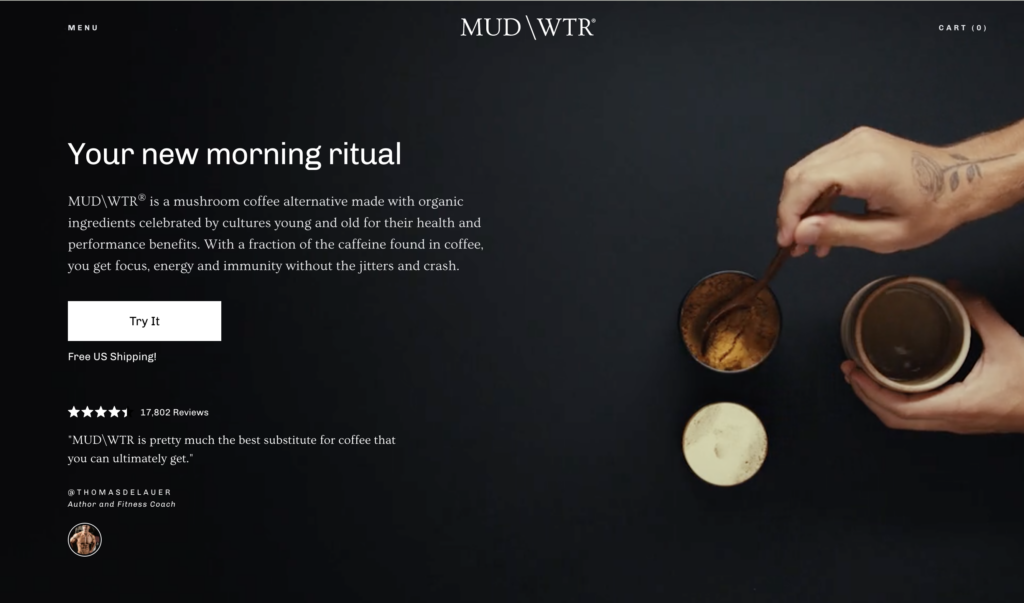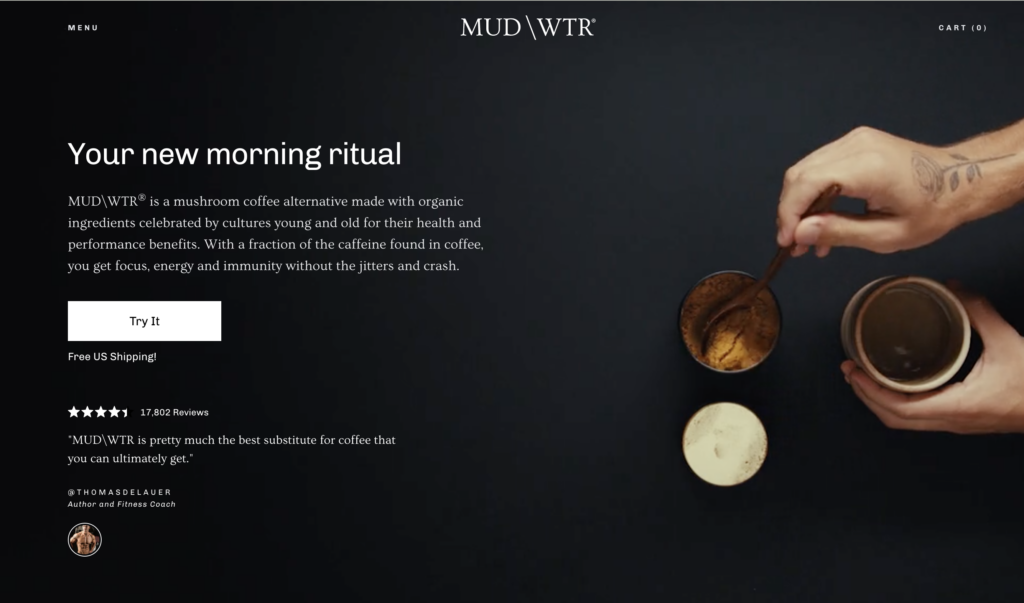THE SPICY COPY BLOG
The 6 Ingredients to Writing Delicious Website Copy
The 6 Ingredients to Writing Delicious Website Copy
Website copy refers to all the words that go on your website and yes, there’s a strategy and an art to writing it.
(And no, I’m not just legally contracted to say that since it’s what I do for a living.)
When it comes to writing website copy there are a few rules you absolutely want to follow.
1 – Make sure it’s clear what you do
I know that may seem obvious, but it’s worth blatantly stating because a lot of times, you’ll land on someone’s website and you can’t figure out exactly what it is that someone offers.
You don’t want to be vague either and say something like “money coach” because that’s not clear enough on its own. What kind of money coach? A financial advisor? Someone who helps people save money? Someone who helps people work on their money mindset?
It’s not only about making it clear what you do in general, it’s about making sure it’s clear to your reader the second they land on your website with the first sentence they read (which is called an above-the-fold statement).
Some stellar examples:

Duo’s above-the-fold statement is amazing because we immediately know:
- They offer marketing services
- They work with passionate entrepreneurs
- They’re a goofy, fun bestie team (thanks to the photo)
The same goes for e-commerce websites like MUD\WTR

- We know MUD\WTR is made from mushrooms
- Is an alternative to coffee while still containing caffeine
- Has health benefits
- Has been tried by 17,248 people (which shows other people trust this product)
Both websites do a great job of immediately telling you what they do which ensures that the people who are interested will keep reading and the ones who aren’t, won’t. And that’s great because we only want our ideal clients to stay. Speaking of which…
2 – Know your ideal client intimately
The key to good copy has been and will always be knowing the person you’re trying to attract, really, really well. Because when you go to write any of the words that represent your business, you’re going to be talking to one person and one person only: your ideal client.
Which means you want to get to know your ideal client freakishly well. You want to know the way they speak, what words they’re Googling to find the answers to their problems, and how they’re feeling about the problem they’re having.
MUD\WTR does an incredible job of speaking to their ideal client’s desires and that’s all showcased within the first 100 words on their website.

First: “your new morning ritual”
- They know the people they’re targeting are coffee drinkers and a huge part of drinking coffee is the morning routine of drinking coffee. By addressing this ritual and desire, they show they understand where their ideal client is coming from
Second: “celebrated by cultures young and old”
- A big part of coffee is the culture, at least for habitual coffee drinkers. Just think about how popular and widespread coffee is – movies, coffee shops, coffee bean snobs. MUD\WTR knows this and by pointing out that mushrooms have a long history too, they address another desire their ideal client has: a beverage with cultural and historical significance
Third: “With a fraction of the caffeine found in coffee, you get focus, energy, and immunity without the jitters and crash.”
- MUD\WTR knows their ideal client wants caffeine but is sick of the negative side effects that come along with it. By highlighting the benefits and directly contrasting them with the negative side effects of coffee, they offer their ideal client a better caffeine alternative
Bottom line: You want to speak directly to your ideal client’s problems and desires, and address any potential hesitations. In other words, write so specifically to their experience that everything they read makes them feel like you’re reading their mind.
3 – Don’t just talk about what you do, talk about the problem you solve
There are a lot of ways to say the same thing.
You could say: “I help people design their websites.” Or, you could say, “designing your own website so it’s not only beautiful but gets you found is hard, that’s where I can help.”
Both sentences communicate that the person helps with website design, but one is way more specific and speaks to something a potential client is actually feeling. Maybe they don’t care that you design websites, but they do care about having a beautiful website that is easy to find on Google.
This idea ties into another big copywriting rule: don’t sell the features, sell the benefits.

(Thank you Marketing Examples for this lovely illustration.)
I can’t remember for the life of me where I read this (and no Google search seemed to help), but the idea went something like this…
Don’t sell the car. Sell never getting to work late again.
Go deeper than just saying the facts of the product, show people what those facts will change in their personal lives.
4 – Avoid using too much “we” and “our”
While it can feel counterintuitive to include so many sentences with “you,” here’s why it works: people are self-interested and you as a business owner want to appeal to that.
Think about yourself! When you go to buy something what you first and foremost care about is how this “something” is going to benefit you.
If it’s a pair of shoes, you want to know if they’ll look good on you. If it’s something like a done-for-you service (like copywriting) you want to know if it’s going to get you results.
So when you’re writing your copy, make sure you’re appealing to that.
There should be more “you’s” than “I’s” and “we’s.”
(And if you don’t have a several-person team, just write in first-person, using “I.”)
For example, check out Tonic’s homepage.

They touch on their brand’s manifesto but all of the emphasis is put on the reader:
- “…what it can do for your brand”
- “Throw out everything you know about templates”
- “…designed for people who give a damn” (this one implies the reader is the type of person who gives a damn)
- “Pick out your new site”
A heavy helping of “you” and a light sprinkling of “we” – that’s the perfect balance when writing your website copy.
5 – Have CTAs (calls to action) sprinkled throughout your website copy
When it comes to copy, you don’t want to leave anything up for interpretation. Your reader needs to be told what to do and when to do it and that’s especially important throughout your website copy.
You want to make it easy for a reader to at any point decide that they’re ready and have a button to press that takes them to the next step.
For example:

When it comes to those CTAs: make it obvious what the CTA is for, don’t include multiple CTAs in one place, and make the CTA a button that stands out from the rest of the text.
(You can have fun and creative CTAs, but you always want to make sure they make sense. When in doubt, clear over clever.)
6 – Include social proof
Other people’s opinions are powerful, especially when it comes to showing others you’re trustworthy. Think about how much time you spend reading reviews before you purchase a product. Or, how much sway it has over you when your friend tells you “this was awesome, you’ve got to do it too.”
The truth is: we want to do the same things other people are doing, especially people we like and trust.
Which is why including social proof is so important in your website copy.
Social proof doesn’t always have to be testimonials either, although those are more than welcome. Social proof can also be DMs, emails, texts, awards, “clients featured in,” and number-based results, just to name a few more ideas.
Some examples:

I love this example from Sarah Kleist’s website because it’s playful and incorporates personal and professional facts. 3+ seltzers consumed per day? Hilarious. 100+ happy design clients. Impressive. And I’d believe it because I’m one of them (that’s right, she designed this very site!).

Aether Diamonds – This brilliant e-commerce business sells diamonds made from captured carbon and their logo bar them gets serious boujee points. We know if brands like Vogue respect this company, it’s a brand we can trust.
7 – And of course, infusing everything with personality is essential
Personality is the secret ingredient that brings everything together. But that topic is so important, it gets a blog post of its own 😉
Editing Checklist
If you’re writing your own website copy, you’ll always want to edit before hitting the publish button. Here are some things to look out for:
1 – Use as few words as possible
- It’s okay to have extra words here and there, but with lengthy sentences, break ideas down as much as you can and always ask yourself: is there a simpler way to say this?
- Remember: When writing, aim for a 5th-8th grade level.
2 – But also, make sure you don’t sound too robotic or stiff
- Using extra words or asking questions to make it feel like your website copy is a two-sided conversation is absolutely worth it. Keep things short and simple, but sprinkle in elements of personality and brand voice.
3 – Read it out loud
- Yep, the whole damn thing because there’s nothing worse than finding a typo in the first sentence of your first paragraph after you’ve shared your website everywhere. Reading it out loud will also help you hear where things sound clunky or what words to place emphasis on. So find a quiet room and do it.
And if you read this whole post and thought, “that sounds like too much work,” I know someone who can do all of it for you (spoiler: it’s me.) 😉